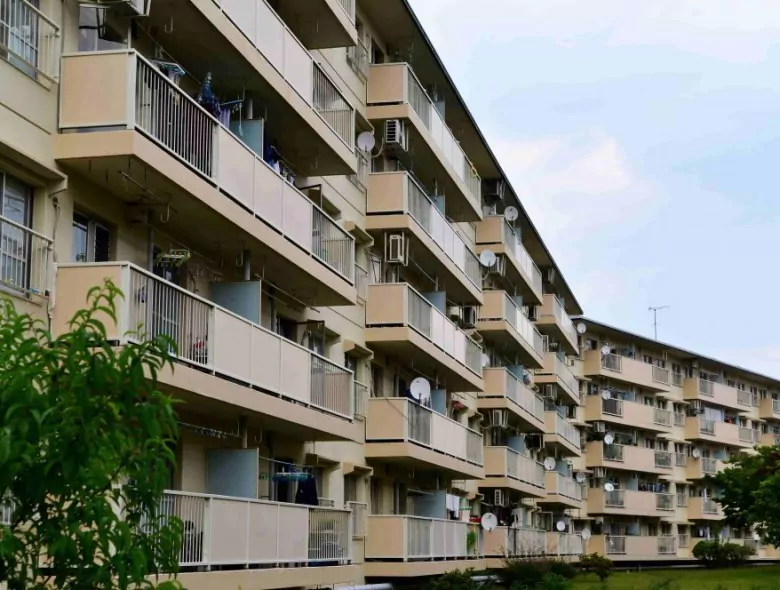Have you ever heard of the term danchi? If so, then you may know that danchi is referring to a specific kind of apartment building, which has become an increasingly popular object for renovation. In fact, many Village House properties are former danchi, which have been beautifully renovated and are now being rented out for affordable prices.
But what are danchi exactly and what’s so special about them? In this article, we’ll take a closer look at it and dive into the history of danchi.

The Origins of Danchi
Many countries have developed experimental public housing, and Japan is no exception. Danchi were one of the first types of mass housing complexes in Japan. Before World War II, there weren’t many large apartments or condominium buildings. Most people lived in houses or small apartment complexes that consisted of only a few units. During the war, 44% of urban residential buildings in Japan were destroyed. To rebuild the economy, the Japanese government invested heavily in industries that would have a fast return. This led to many jobs being clustered in urban areas and people flocking to cities like Tokyo for work. With this new increase in the urban population came an urgent need for more housing.
By the 1950s, the population of Japan’s cities had grown so much that the government had no choice but to act and develop more housing. In 1955, the Japan Housing Corporation, which was tasked with solving the housing problem, was established. After researching what types of housing would be suitable for the rapidly growing urban population, the Japan Housing Corporation began building danchi.

To create danchi, the Japan Housing Corporation took inspiration from Soviet Khrushchyovka, which are largely low-cost apartment complexes originally built as temporary housing. While the exterior of danchi resembles Khrushchyovka, the interiors have a more Japanese aesthetic. Most danchi have a few multi-purpose tatami rooms, as well as a kitchen and bathroom.

Danchi as Modern, Convenient Urban Dwellings
From the 1950s to the 1970s, danchi were considered a symbol of modern, futuristic life. The majority of danchi are in cities and were built close to public transportation and stores. Living in a danchi was quite affordable. The rent was less than that of higher-end apartments or condominiums and mortgages. The low cost of danchi, as well as their urban location, helped introduce the structure of the nuclear family to Japan. Before the war, it was common for families to live in multigenerational homes. Danchi allowed young couples who came into cities for work to live on their own. This privacy from older family members also made danchi popular among newlyweds, who went on to raise children in the large urban apartment complexes.

The Fall of Danchi
In the 1970s, the Japanese government decided that enough public housing had been built and the housing crisis was solved. As young people who moved into danchi throughout the 1950s and 60s grew older and saved up money, they started buying their own homes and moving out. As a result, danchi began to lose their modern appeal. Newer forms of housing created throughout the 1980s and 90s became more popular, and many danchi were being demolished by the 2000s.
Nowadays, danchi are quite stigmatized. They are thought of as old public housing for very poor people. Most modern-day danchi residents are elderly, low-income, single-parent families, or immigrants. Few people would want to admit to living in a danchi. Also, the buildings are quite outdated and not up to modern living standards. They tend to be very cold in the winter and overheat in the summer. Furthermore, they suffer from accessibility issues, causing problems for elderly and disabled residents.

Renovating Danchi
Recently, renovating danchi has come into fashion. Different agencies have started working together with trendy brands such as Muji to make renovations to danchi. Muji’s minimalist aesthetics have been brought into danchi, making them modern again. Village House has also renovated danchi, fixing up both the exterior and interior of the old apartment complexes. Renovated danchi no longer resemble Khrushchyovka and are not comprised of old-fashioned tatami rooms.
While there are costs associated with renovating, modern-day danchi are still more affordable than newer “mansions” (apartments) and condominiums. Older buildings are generally cheaper to rent, and many renovated danchi are still public housing units. In Japan, it’s common for old buildings to be demolished. Many residents of older homes have their houses rebuilt, and wealthier neighborhoods are full of new condominium buildings. However, as danchi renovation projects show, it’s possible to save money and resources – and create something cool – by using creativity to make renovations.
So, as you can see, danchi are in no way inferior to other apartment complexes, and it rather has its advantages living in one! If you are still looking for a nice, budget-friendly new home, please consider checking out Village House’s available rental apartments!



